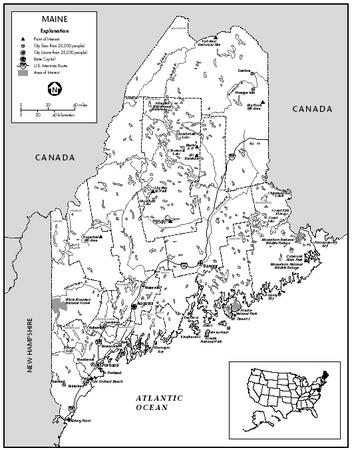Maine
Languages
Descendants of the Passamaquoddy and Penobscot Indians of the Algonkian family who inhabited Maine at the time that European settlers arrived still lived there in the mid-1980s. Algonkian place-names abound: Saco, Millinocket, Wiscasset, Kennebec, Skowhegan.
Maine English is celebrated as typical Yankee speech. Final /r/ is absent, a vowel sound between /ah/ and the /a/ in cat appears in car and garden, aunt and calf . Coat and home have a vowel that to outsiders sounds like the vowel in cut . Maple syrup comes from rock or sugar maple trees in a sap or sugar orchard ; cottage cheese is curd cheese; and pancakes are fritters .
In 2000, 92.2% of Maine residents five years old or older reported speaking only English in the home, up from 90.8% in 1990.
The decline of parochial schools and a great increase in the number of young persons attending college have begun to erode the linguistic and cultural separateness that marks the history of the Franco-American experience in Maine.
The following table gives selected statistics from the 2000 census for language spoken at home by persons five years old and over. The category "Other Native North American languages" includes Apache, Cherokee, Choctaw, Dakota, Keres, Pima, and Yupik. The category "Other Indo-European languages" includes Albanian, Gaelic, Lithuanian, and Rumanian. The category "Scandinavian languages" includes Danish, Norwegian, and Swedish.


| LANGUAGE | NUMBER | PERCENT |
| Population 5 years and over | 1,204,164 | 100.0 |
| Speak only English | 1,110,198 | 92.2 |
| Speak a language other than English | 93,966 | 7.8 |
| Speak a language other than English | 93,966 | 7.8 |
| French (incl. Patois, Cajun) | 63,640 | 5.3 |
| Spanish or Spanish Creole | 9,611 | 0.8 |
| German | 4,006 | 0.3 |
| Italian | 1,476 | 0.1 |
| Chinese | 1,259 | 0.1 |
| Other Native North American languages | 1,182 | 0.1 |
| Mon-Khmer, Cambodian | 1,084 | 0.1 |
| Vietnamese | 911 | 0.1 |
| Russian | 896 | 0.1 |
| Other Indo-European languages | 785 | 0.1 |
| Scandinavian languages | 779 | 0.1 |
| Tagalog | 771 | 0.1 |
| Greek | 767 | 0.1 |